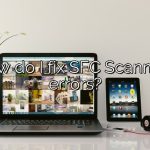
How to decode windows errors?
Click Start.
In the search bar, type CMD .
Right-click CMD.exe and select Run as Administrator.
On the User Account Control (UAC) prompt, click Yes.
In the command prompt window, type SFC /scannow and press Enter .
System file checker utility checks the integrity of Windows system files and repairs them if required.
How to scan Windows 10 for errors?
First, right-click on the Start button and select Command Prompt (Admin).
When each prompt appears, paste what you need: sfc /scannow
Keep the window open while scanning, which may take some time depending on your layout and hardware.
How to check genuine windows?
Follow the same steps if you need to access the command line.
Enter slmgr.vbs /dli
Press Enter.
Check the Windows Script Host.
If the “License” status is “License”, your company is running genuine Windows.
How to decode windows errors?
1 – – rpm
2 Delivery (COM delivery)
3 – Storage (OLE storage)
4 – ITF (COM/OLE Interface Control)
7 – Win32 (raw Win32 error codes)
8 – window
9—SSPI
10 – control
11 – CERT (client or server certificate)
How do I find Windows errors?
Open the Event Viewer by clicking the Start button.
Click Control Panel.
Click System and Security.
Click Manage.
Click Event Viewer.
What is the Windows error-checking tool?
The Microsoft Error Checking utility scans your hard drive for bad sectors and system image errors to determine with absolute certainty if any files or folders are misplaced, and then fixes the errors. This error checking utility may also be called Check Disk. Use it to find and fix hard drive errors. Close all open entries.
What is SFC command?
The sfc command is a command line command that can be used to check and replace important Windows feature files. Many troubleshooting steps recommend using the sfc command. System File Checker is a very useful and interesting tool that you can use when you encounter problems with protected Windows files such as directories and many DLL files.
Should I run DISM or SFC first?
SFC can verify the integrity of all protected operating system files, including those that are not on your hard drive. Dism liquid should be used first.

Charles Howell is a freelance writer and editor. He has been writing about consumer electronics, how-to guides, and the latest news in the tech world for over 10 years. His work has been featured on a variety of websites, including techcrunch.com, where he is a contributor. When he’s not writing or spending time with his family, he enjoys playing tennis and exploring new restaurants in the area.










